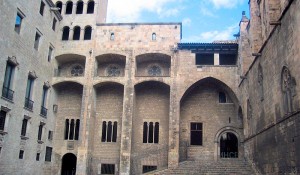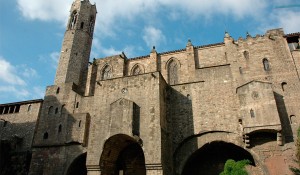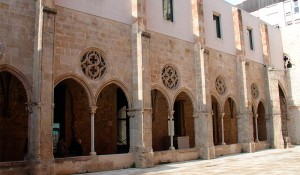Monuments
If there is anything the district has its large number of monuments, churches, palaces...
Monastery of Santa Anna
The monastery of Santa Ana was founded in the mid-twelfth century by the canons of the Holy Sepulchre
The church of Santa Anna, which is located in a fenced and landscaped, behind Catalonia Square was originally a Greek cross plan with a rectangular apse.

Palacio Reial Major y Palacio del Lloctinent
The Royal Palace was the official residence of the Counts of Barcelona and later of the kings of Catalonia and Aragon.
The old Royal Palace of Barcelona currently consists of three separate buildings, which are the Royal Palace itself, headed by the great hall of the Tinell, an annex of this palace today, much restored and expanded, the Museum Seas and the Lieutenant Palace, which housed the General Archive of the Crown of Aragon.

Royal Chapel of Santa Ágata
The chapel, which was part of the Royal Palace, was built from 1302 by disposition of King James II and his wife Blanca d'Anjou
Located between the Plaza del Rey and Ramon Berenguer III, on the ancient Roman wall, rises the Chapel of St. Agatha. The building has a single nave with wooden roof gable that rests on pointed diaphragm arches and exterior buttresses.

Palace Requesens
Located in the district of San Justo, Palau Requesens, also said the Countess of Palamos, was the largest private palace of medieval Barcelona. Today is headquarters of the Royal Academy of Arts
The building was built in the thirteenth century, but as it has come down to us is basically a Gothic building, later reforms. Based on the Roman wall, an arch connecting two towers of the wall in order to give substance to the new building.

Palace Chapel
The history of this building runs largely parallel to the Royal Palace Minor Barcelona, also known as the Palace of the Countess, disappeared in the nineteenth century
The building known as the Old Palace chapel has its origins in the thirteenth century, renovated between 1542 and 1547 and restored by Elies Rogent 1868, today known as Our Lady of Victory.

House of Canons
Originally, the Houses of the Canons were a heterogeneous group of independent houses the only common feature being canonical residences
The different facades that make up the set are the result of an aggressive transformation of the end of the twenties century. XX for providing the set of a medieval character.

Episcopal Palace
The building known as the Bishop's Palace is a religious residential building that has its origins to the thirteenth century
The building now known as the Palace of the Bishop is the first building of the new episcopal Barcelona that rises walled city of Barcelona, using the utensils inside the Roman walls.

Monastery of Sant Pere de les Puel·les
The monastery of Sant Pere de les Puelles was founded around the year 945 by the counts Sunyer and Riquilda facing the atrium of the church of Sant Sadurní
The present church, which has undergone many transformations, is a building plan of a Greek cross, covered with barrel vaults.

Old convent of St. Agusti
The Old Convent of St. Augustine was a convent of the Order of Saint Augustine located in the Ribera district of Barcelona
Its construction began in 1349. After the siege of 1713-1714, due the construction of the fortress of the Citadel, the Augustinians were moving in the Raval neighborhood, at Hospital Street, where between 1728 and in 1750 they built a new church and convent of San Agustin new.

Palace of the Marquès de Lió
The interior of the building retains all the original layout, as in the eighteenth century its owner, Josep Mora and tasting, first Marquis of Llió, turned into a paper mill
Behind the palace he built a paper mill remained in operation until 1990.

Nadal Palace
Built during the fifteenth century, Renaissance elements mixed with Gothic
In the inner courtyard is noteworthy a window on the top floor of polilobulado bow, and a man's head and another woman as a capitals.

Palace Cervelló-Giudice
It is located in a palace of Montcada which was built mainly during the sixteenth century, using parts of a previous construction of the fifteenth century
It was the residence of the noble family of Cervello until the eighteenth century, when it became the residence of Giudice, an important line of Genoese merchants.


















